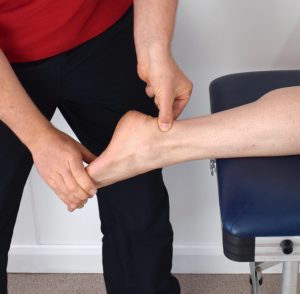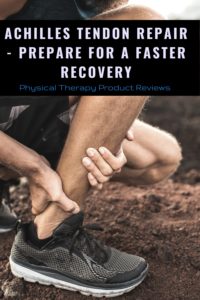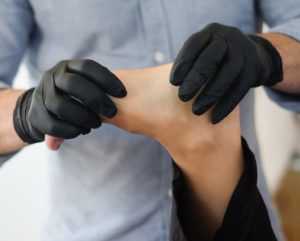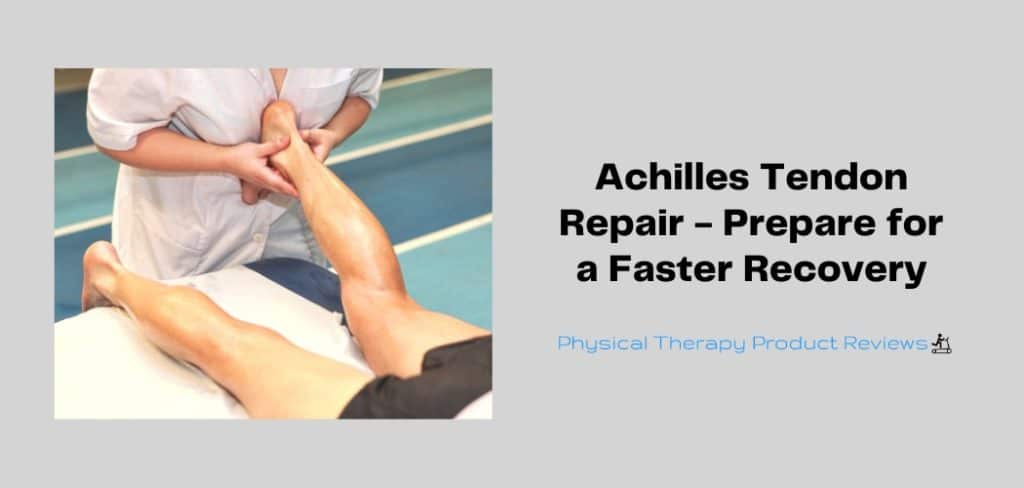The Achilles tendon is a tough band of tissue connecting your calf muscle to your heel bone. This tendon is the largest and strongest tendon in the body. It plays a key role in running, jumping, and walking.

The Achilles tendon is susceptible to injury due to its limited blood supply and the high levels of tension placed on it. Whether injury results in a tear or rupture, a common Achilles tendon repair surgery can bring this powerful tendon back to its original vigor.
The Achilles tendon can be repaired via open or closed surgery. With either surgery, there are steps you can take to make recovery a little faster and easier.
Achilles Tendon - Effective Prehab Leads to Faster Recovery
Prehabilitation is a specific exercise program that is implemented before major surgery. This concept is based on the idea that patients with higher strength and function before surgery will improve their postoperative outcomes.
 Some of the most important exercises to focus on before surgery focus on the strength of the other muscles in the lower leg. These exercises help maintain a good range of motion before going into surgery. We recommend stretching the Soleus, working on ankle motion, and improving the strength of your Tibialis Posterior.
Some of the most important exercises to focus on before surgery focus on the strength of the other muscles in the lower leg. These exercises help maintain a good range of motion before going into surgery. We recommend stretching the Soleus, working on ankle motion, and improving the strength of your Tibialis Posterior.
With prehab for an Achilles Tendon repair, you also want to focus on the major muscle groups that will help you during your recovery. Think about any exercises to help strengthen the quads, hamstrings, and glutes.
- Bridges
- Squats
- Hamstring Curls
- and the leg press
Being Prepared for an Achilles Tendon Repair Decreases Pre Surgery Jitters
Feeling prepared for surgery will help reduce any anxiety you are having. We recommend having all of your supplies ready, getting your house setup, and lining up help before you head into surgery. We’ve compiled a list of things to do before surgery day.
Crutches
You will need crutches for up to 6 weeks as you let your tendon heal. You can use the standard metal crutches but after a few days, those can get old and uncomfortable. For anyone needing crutches for longer than 2 weeks, we recommend the Mobilegs Crutches which are more comfortable, lighter, and easier to maneuver.
You may also think about getting a knee scooter if you have to walk long distances to work or have kids that you need to be active around the house. The knee scooter lets you bear weight through the knee joint while still protecting your surgically repaired tendon.
Get an Automatic Ice Machine

Ice packs are great but can be a pain. To make it easier we recommend getting an automatic ice machine. This is a wearable brace that circulates ice water through to keep it cold. It has an automatic shut off so you can wear it to bed without having to worry about it going all night long. It’s simply easier than having to use an ice pack and returning to the freezer every time your ice melts. Plus, it’s nice to have around for future injuries.
Move Your Sleeping Area Downstairs
Watch out for stairs; they are a beast with crutches. For the initial 6-8 weeks after surgery, you won’t want to navigate stairs. We suggest moving down to a lower level room next to a bathroom with all of the things that you need. Keep a leg elevator pillow, your ice machine, leg lifter, and bathroom supplies nearby so you don’t have to move far.
Prepare Your House
You may not have thought about it before, but now is the time to declutter and move things around that could become a tripping hazard. Put away heavy throw rugs, move dog beds, put shoes away, and spread the furniture out. The last thing you want to do is catch the edge of the rug and fall on your newly repaired ankle.
What to Expect After an Achilles Tendon Repair
After your surgery, you will be given a specific protocol that is imperative to follow. In the first 2 weeks expect to be non-weight bearing, with a focus on learning the proper use of crutches.
In the next 3-6 weeks, you will slowly start to add weight-bearing and range of motion exercises to your routine. Working specifically on ankle plantarflexion, inversion, and eversion, but continuing to avoid dorsiflexion.
At week 8, you can expect to start working on your dorsiflexion motion with your surgeon’s approval. At this point, expect to work on lower extremity strengthening, specific activity training, and extensive work on normalizing gait mechanics. If you are working to get back to sports, expect to spend extensive time with your Physical Therapist.
The largest risk of re-rupture occurs between the 6 weeks and 4-month mark, so for athletes looking to get back to sports, you can expect to take 6 months to a year in rehab.
No matter what your post-rehab goals are, to get the most out of your rehabilitation experience work with your Physical Therapist to create a program specific to your long-term goals and to get you back to things you love to do.

P.R.I.C.E.
After surgery, your surgeon will suggest these simple guidelines that can easily speed up your recovery.
Protection
Post-surgery the surgeon will give you strict weight-bearing guidelines specific to your surgery. You must adhere to these directions so you can give your body time to heal and prevent any further injury.
Rest
This one is as simple as it sounds, gives you time to rest, and allow your body to heal and recover. Avoid any activities (big or small) that can cause stress to the body or mind as this can slow or prevent the healing process.
Ice
Ice is used to minimize and reduce any post-surgical pain. Try 10-15 minutes multiple times throughout the day.
Our favorite way to ice after surgery is by using an automatic icing machine. These machines circulate cold water to the joint and can be set on a timer so that you can fall asleep with pain relief and not worry about getting ice damage to the skin.
Compression
Post-surgery you will be put in either a cast or splint that will not only provide ample compression but also restrict your movement. Adhere to the wearing schedule provided by your medical professional.
Elevation
Another important recommendation. Elevation helps reduce swelling to the surgical area and can help decrease pain and help speed up the healing process. Try elevating the extremity above the heart for periods throughout the day.
Start Safe Exercises Immediately After Surgery
Even though you just had surgery there are exercises that you can do immediately while your Achilles is healing. You won’t be able to do much with your foot for the first 6-8 weeks but you can still set yourself up for success after. Here are some safe exercises to do with your boot on.
How to Do a Dead Bug
Dead Bugs
This exercise focuses on core strength and pelvic control.
- Start lying on your back, with your arms and legs up above you, and your core engaged.
- While bracing through your abdominals slowly lower one leg towards the floor while the OPPOSITE arm also lowers towards the floor.
- The main part of the exercise is to keep your back flat on the floor or table
Side-Lying Hip Abduction
This is great to do on both sides.
- Start by lying on your side with the bottom knee bent and with a resistance band around the leg just above the knee.
- Raise your hip leg toward the ceiling without rotating at the spine.
- Slowly lower it back down to the other leg while fighting the resistance band.
- Repeat 30 times and sigh in amazement a how fatiguing this exercise is.
Knee Extensions with Band
This exercise targets the quads and will help compensate for your calf when you get out of the boot. You can do this at home or the gym.
- In a sitting position on the edge of the bed wrap a band around the feet.
- While keeping one leg down and providing an anchor for resistance, straighten your other leg.
- Slowly lower back to a bent position.
Doctor Knows Best
While recovering from an Achilles tendon repair it is extremely important to follow the recommendations of your surgeon. Coming out of surgery pain management is imperative. By managing pain you will be able to sleep through the night, but also make it through your rehab exercises. If the prescribed medications are not agreeing with your stomach, speak to your doctor about another pain medication.
Also, make sure to listen to the suggestions of your Physical Therapist. They know how to successfully get you through this tough recovery process. From recommendations for a more comfortable sleep, pain management techniques, specific exercise modifications, and cues for an effective gait your Physical Therapist know to help you through it all.
No matter the medical professional you are consulting with before or after your surgery take their recommendations to heart. They have the knowledge and experience to help you be successful in recovery.
Works Cited
Blyth, V., Moorthy, K. (2017). Prehabilitation: preparing patients for surgery. British Medical Journal, 358(10), 321-325. doi: 10.1136/bmj.j3702
Carter, T. R., Fowler, P. J., & Blokker, C. (1992). Functional postoperative treatment of Achilles tendon repair. The American Journal of Sports Medicine, 20(4), 459-462. doi:10.1177/036354659202000417
Ismail, M., Karim, A., Shulman, R., Amis, A., & Calder, J. (2008). The Achillon Achilles Tendon Repair: Is it Strong Enough? Foot & Ankle International, 29(8), 808-813. doi:10.3113/fai.2008.0808
Suchak, A., Spooner, C. (2007). Postoperative rehabilitation protocols for achilles tendon ruptures: a meta-analysis. Clinical Orthopaedics & Related Research, 445(45), 216-221. doi: 10.1097/01.blo.0000203458.05135.74
Other Great Rehab Related Articles
How to Stay Active After Cervical Fractures: Expert Tips and Advice
Dealing with Painful Stairs After Ankle Replacement Surgery
Walking After a Total Ankle Replacement: Tips for a Successful Recovery
Exercises While Non-Weight Bearing After Ankle Replacement: Elevation, AROM, Leg Raises, and More
Ankle Pain with Stairs: Causes and Home Treatment Options
5 Common Mistakes You’re Making After an Ankle Sprain
Disclaimer: The information provided in this post is for educational purposes only. This is not a substitute for a medical appointment. Please refer to your physician before starting any exercise program.









Comments are closed.